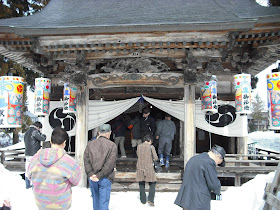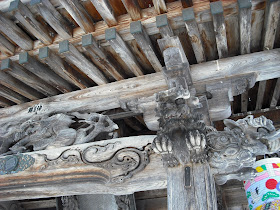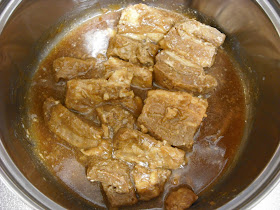On Friday, March 12, I went to the festival called Nogu Ichi (Farm Tool Market), held at Ichinomiya Shrine, located here in Ozato, Minami Uonuma city, Niigata. According to the
official website, this festival is called Shunki Taisai (Springtime Big Festival).
This festival, held on March 12 every year, dates back to the Edo period. It started as a market of farm tools and other merchandise aimed at visitors to the spring festival held at the shrine. Someone told me that in days of old, there used to be a continuous flow of people from the Shiozawa Station on Joetsu Line to this shrine on this particular day.
The festival is now less popular, but is still loved by many people. It is said in this region that spring will come after this festival ends.
3月12日(金)、新潟県南魚沼市の大里(おおざと)にある一宮神社(いちのみやじんじゃ)で行われた農具市(のうぐいち)に行って来ました。
公式サイトによると、 このお祭りは春季大祭と呼ばれています。
毎年3月12日に行われるこの祭りは、江戸時代に遡ります。神社で行われた春祭りに来る参拝者を狙って、農具や他の商品を売る市として始まりました。昔はこの日には、上越線の塩沢駅からこの神社まで人の流れが絶えなかった、と或る人から聞きました。今ではそれ程人気はないですが、それでも多くの人に愛されています。この地域では、このお祭りの後に春が来ると言われています。
I walked to the festival site. While walking, I took some photos like these:
お祭りには歩いて行きました。歩いている途中、こんな写真を撮りました。
Southeast side:
南東側:

You can see Mt. Iiji on the right side of the photo, where Centleisure Maiko Snow Resort is located.
写真の右側には飯士山(いいじさん)が見えます。セントレジャー舞子スノーリゾートがあります。
Southwest side:
南西側:

You can see Ishiuchi Maruyama ski resort.
The line of trees at the center of the photo is that of sakura. I'd like to take photos of the sakura when they are in bloom.
石打丸山スキー場が見えます。
写真中央の並木は桜です。桜が咲いたら、写真を撮りたいと思います。
Mt. Makihata on the left near the center:
左側中央近くに巻機山(まきはたやま):

Uono River, which runs through Minami Uonuma city, Mt. Sakado, and Mt. Hakkai:
南魚沼市を流れる魚野川(うおのがわ)、坂戸山(さかとやま)、八海山(はっかいさん)

We still have this much snow on the ground.
地面にはまだこれだけ雪があります。

I arrived at the site. Kushiyaki and Tenshin amaguri (lit. Chinese sweet chestnut) stalls:
場所に着きました。串焼きと天津甘栗の店:

Fruit and vegetable stall and takoyaki stall:
野菜果物の店とたこ焼きの店:

I bought some komatsuna, yama udo, and gobo (described later) from the stall.
このお店で小松菜、山うど、ゴボウ(後述)を買いました。
Taiyaki and ikayaki (grilled squid) stalls:
たい焼きとイカ焼きの店:

Shichimi togarashi stall and another Tenshin amaguri stall:
七味とうがらしの店と、別の天津甘栗の店:

Other photos to share:
他の写真:











The shrine came in sight.
神社が見えてきました。










Here are the items I bought:
私が買った物:
Komatsuna:
小松菜(コマツナ):

Yama udo (Aralia cordata) and gobo (burdock roots)

Yama means mountain, suggesting something wild. I didn't know why cultured udo are sold by the name of yama udo. I did some googling and found that there are things called nanpaku (soft and white) udo, also called, Tokyo udo, which are entirely white because they are cultured in dark places, and that yama udo are made by applying sunlight to nanpaku udo to make them green and increase the fragrance.
「山」というと野生のような感じですが、なぜ栽培のウドを山うどと言う名で売っているのか知りませんでした。グーグルで検索すると、軟白ウド(東京ウドとも呼ばれる)というものがあり、それは暗いところで栽培されるので、全体が白いと言うことと、山うどは軟白ウドに太陽の光を当て、緑色にして、香りを強くしたものだと分かりました。
Cod, cut into chunks, and wakasagi (Japanese smelt) tsukudani:
ぶつ切りにしたタラとワカサギの佃煮:

Komochi shishamo (shishamo with roe in them):
子持ちシシャモ:

Not real shishamo but capelin.
I prepared the cod to use for use in tara jiru (code soup) the next day.
Left: Shirako (milt)
Put in a bowl, sprinkle sake, let stand for 10 min, rinse with salt water, and drain with paper towels.
Right: Flesh
Rinse with salt water quickly, pat dry, put in a vat, and sprinkle salt, let stand for 10 min., and wipe with paper towels.
タラは、翌日タラ汁に使うため下準備しました。
左: 白子
ボールに入れ、酒をかけて、10分おき、塩水で洗って、キッチンペーパーで拭き取る。
右: 身
塩水でさっと洗い、水気を取って、バットにおき、塩をかけ、10分置き、キッチンペーパーで拭き取る。


















































































